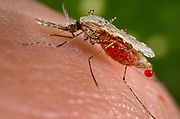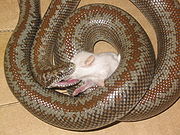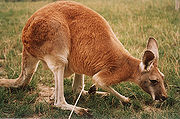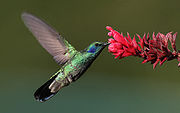
Feeding
Encyclopedia
Feeding is the process by which organisms, typically animal
s, obtain food
. Terminology often uses either the suffix
-vore from Latin vorare, meaning 'to devour', or phagy, from Greek φαγειν, meaning 'to eat'.








later, plants (herbivory). Carnivory was a natural transition from insectivory for medium and large tetrapods, requiring minimal adaptation (in contrast, a complex set of adaptations was necessary for feeding on highly fibrous plant materials).
of form and function, such as:
Animal
Animals are a major group of multicellular, eukaryotic organisms of the kingdom Animalia or Metazoa. Their body plan eventually becomes fixed as they develop, although some undergo a process of metamorphosis later on in their life. Most animals are motile, meaning they can move spontaneously and...
s, obtain food
Food
Food is any substance consumed to provide nutritional support for the body. It is usually of plant or animal origin, and contains essential nutrients, such as carbohydrates, fats, proteins, vitamins, or minerals...
. Terminology often uses either the suffix
Suffix
In linguistics, a suffix is an affix which is placed after the stem of a word. Common examples are case endings, which indicate the grammatical case of nouns or adjectives, and verb endings, which form the conjugation of verbs...
-vore from Latin vorare, meaning 'to devour', or phagy, from Greek φαγειν, meaning 'to eat'.








Evolutionary history
The evolution of different feeding strategies is varied with some feeding strategies evolving several times in independent lineages. In terrestrial vertebrates, the earliest forms were large amphibious piscivores 400 million years ago. While amphibians continued to feed on fish and later insects, reptiles began exploring two new food types, other tetrapods (carnivory), andlater, plants (herbivory). Carnivory was a natural transition from insectivory for medium and large tetrapods, requiring minimal adaptation (in contrast, a complex set of adaptations was necessary for feeding on highly fibrous plant materials).
Evolutionary adaptations
The specialization of organisms towards specific food sources is one of the major causes of evolutionEvolution
Evolution is any change across successive generations in the heritable characteristics of biological populations. Evolutionary processes give rise to diversity at every level of biological organisation, including species, individual organisms and molecules such as DNA and proteins.Life on Earth...
of form and function, such as:
- mouthMouthThe mouth is the first portion of the alimentary canal that receives food andsaliva. The oral mucosa is the mucous membrane epithelium lining the inside of the mouth....
parts and teethToothTeeth are small, calcified, whitish structures found in the jaws of many vertebrates that are used to break down food. Some animals, particularly carnivores, also use teeth for hunting or for defensive purposes. The roots of teeth are embedded in the Mandible bone or the Maxillary bone and are...
, such as in whaleWhaleWhale is the common name for various marine mammals of the order Cetacea. The term whale sometimes refers to all cetaceans, but more often it excludes dolphins and porpoises, which belong to suborder Odontoceti . This suborder also includes the sperm whale, killer whale, pilot whale, and beluga...
s, vampire batVampire batVampire bats are bats whose food source is blood, a dietary trait called hematophagy. There are three bat species that feed solely on blood: the Common Vampire Bat , the Hairy-legged Vampire Bat , and the White-winged Vampire Bat .All three species are native to the Americas, ranging from Mexico to...
s, leechLeechLeeches are segmented worms that belong to the phylum Annelida and comprise the subclass Hirudinea. Like other oligochaetes such as earthworms, leeches share a clitellum and are hermaphrodites. Nevertheless, they differ from other oligochaetes in significant ways...
es, mosquitoMosquitoMosquitoes are members of a family of nematocerid flies: the Culicidae . The word Mosquito is from the Spanish and Portuguese for little fly...
s, predatory animals such as felineFelidaeFelidae is the biological family of the cats; a member of this family is called a felid. Felids are the strictest carnivores of the thirteen terrestrial families in the order Carnivora, although the three families of marine mammals comprising the superfamily pinnipedia are as carnivorous as the...
s and fishFishFish are a paraphyletic group of organisms that consist of all gill-bearing aquatic vertebrate animals that lack limbs with digits. Included in this definition are the living hagfish, lampreys, and cartilaginous and bony fish, as well as various extinct related groups...
es, etc. - distinct forms of beakBeakThe beak, bill or rostrum is an external anatomical structure of birds which is used for eating and for grooming, manipulating objects, killing prey, fighting, probing for food, courtship and feeding young...
s in birds, such as in hawkHawkThe term hawk can be used in several ways:* In strict usage in Australia and Africa, to mean any of the species in the subfamily Accipitrinae, which comprises the genera Accipiter, Micronisus, Melierax, Urotriorchis and Megatriorchis. The large and widespread Accipiter genus includes goshawks,...
s, woodpeckerWoodpeckerWoodpeckers are near passerine birds of the order Piciformes. They are one subfamily in the family Picidae, which also includes the piculets and wrynecks. They are found worldwide and include about 180 species....
s, pelicanPelicanA pelican, derived from the Greek word πελεκυς pelekys is a large water bird with a large throat pouch, belonging to the bird family Pelecanidae....
s, hummingbirdHummingbirdHummingbirds are birds that comprise the family Trochilidae. They are among the smallest of birds, most species measuring in the 7.5–13 cm range. Indeed, the smallest extant bird species is a hummingbird, the 5-cm Bee Hummingbird. They can hover in mid-air by rapidly flapping their wings...
s, parrotParrotParrots, also known as psittacines , are birds of the roughly 372 species in 86 genera that make up the order Psittaciformes, found in most tropical and subtropical regions. The order is subdivided into three families: the Psittacidae , the Cacatuidae and the Strigopidae...
s, kingfisherKingfisherKingfishers are a group of small to medium sized brightly coloured birds in the order Coraciiformes. They have a cosmopolitan distribution, with most species being found in the Old World and Australia...
s, etc. - specialized clawClawA claw is a curved, pointed appendage, found at the end of a toe or finger in most mammals, birds, and some reptiles. However, the word "claw" is also often used in reference to an invertebrate. Somewhat similar fine hooked structures are found in arthropods such as beetles and spiders, at the end...
s and other appendages, for apprehending or killing (including fingers in primatePrimateA primate is a mammal of the order Primates , which contains prosimians and simians. Primates arose from ancestors that lived in the trees of tropical forests; many primate characteristics represent adaptations to life in this challenging three-dimensional environment...
s) - changes in body colour for facilitating camouflageCamouflageCamouflage is a method of concealment that allows an otherwise visible animal, military vehicle, or other object to remain unnoticed, by blending with its environment. Examples include a leopard's spotted coat, the battledress of a modern soldier and a leaf-mimic butterfly...
, disguise, setting up traps for preys, etc. - changes in the digestiveDigestionDigestion is the mechanical and chemical breakdown of food into smaller components that are more easily absorbed into a blood stream, for instance. Digestion is a form of catabolism: a breakdown of large food molecules to smaller ones....
system, such as the system of stomachStomachThe stomach is a muscular, hollow, dilated part of the alimentary canal which functions as an important organ of the digestive tract in some animals, including vertebrates, echinoderms, insects , and molluscs. It is involved in the second phase of digestion, following mastication .The stomach is...
s of herbivores, commensalismCommensalismIn ecology, commensalism is a class of relationship between two organisms where one organism benefits but the other is neutral...
and symbiosisSymbiosisSymbiosis is close and often long-term interaction between different biological species. In 1877 Bennett used the word symbiosis to describe the mutualistic relationship in lichens...
By mode of ingestion
There are many modes of feeding that animals exhibit, including:- filter feedingFilter feederFilter feeders are animals that feed by straining suspended matter and food particles from water, typically by passing the water over a specialized filtering structure. Some animals that use this method of feeding are clams, krill, sponges, baleen whales, and many fish and some sharks. Some birds,...
- obtaining nutrients from particles suspended in water - deposit feeding - obtaining nutrients from particles suspended in soil
- fluid feedingFluid feederFluid feeders are organisms that feed on the fluid of other organisms. It can refer to:*Hematophagy, feeding on blood*Nectarivore, feeding on nectar*Plant sap feeders...
- obtaining nutrients by consuming other organisms' fluids - bulk feeding - obtaining nutrients by eating all of an organism
- Ram feeding and Suction feeding - ingesting prey via the fluids around it.
By mode of digestion
- Extra-cellular digestionExtra-cellular digestionExtra-cellular digestion is a process where saprobionts feed by secreting enzymes through the cell membrane onto the food which is in the digestive system spaces. The enzymes catalyse the food into molecules small enough for them to be phagocytosed...
- excreting digesting enzymes and then reabsorbing the products - MyzocytosisMyzocytosisMyzocytosis is a method of feeding found in some heterotrophic organisms...
- one cell pierces another using a feeding tube, and sucks out cytoplasm - Phagocytosis - engulfing food matter into living cells, where it is digested

